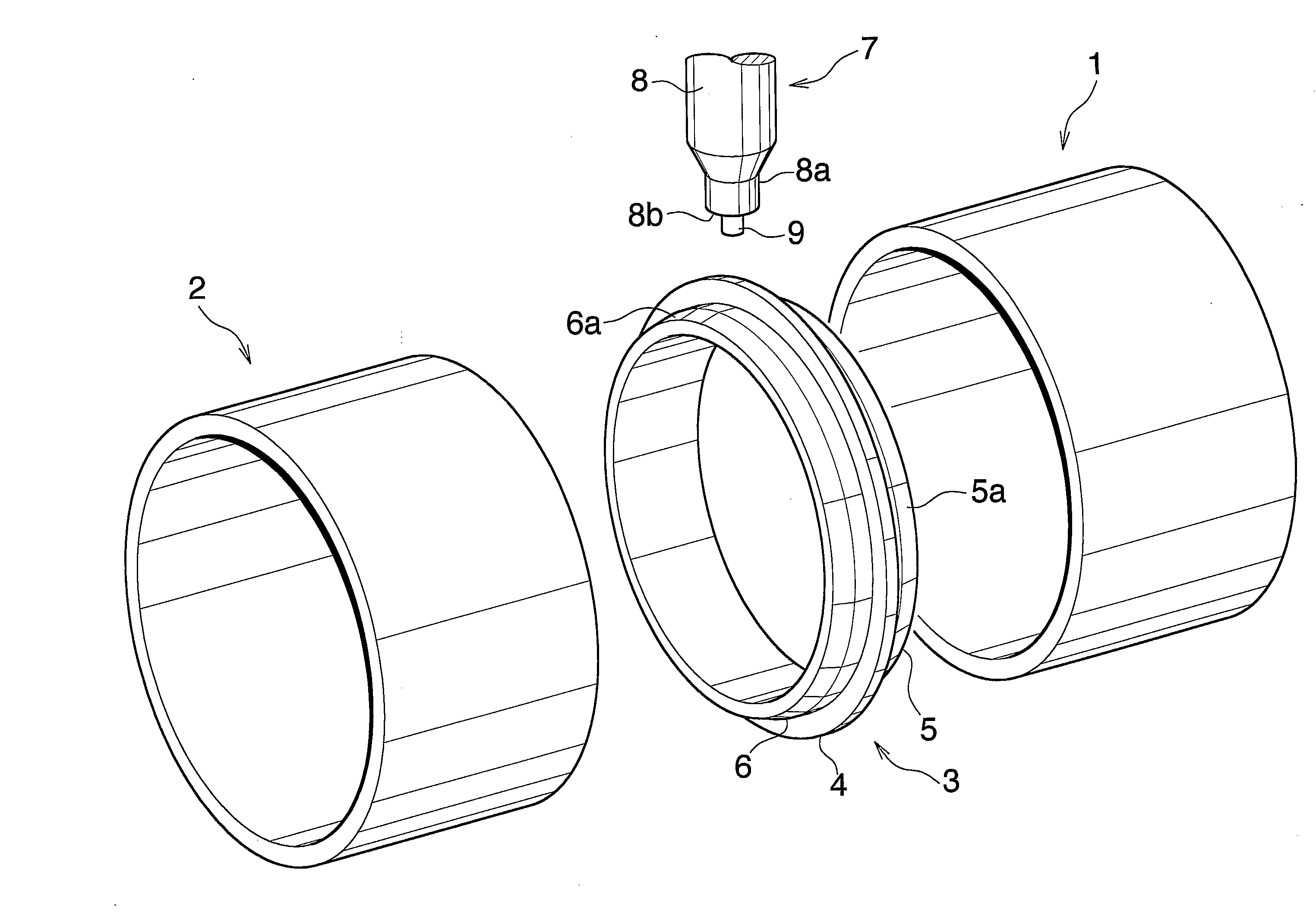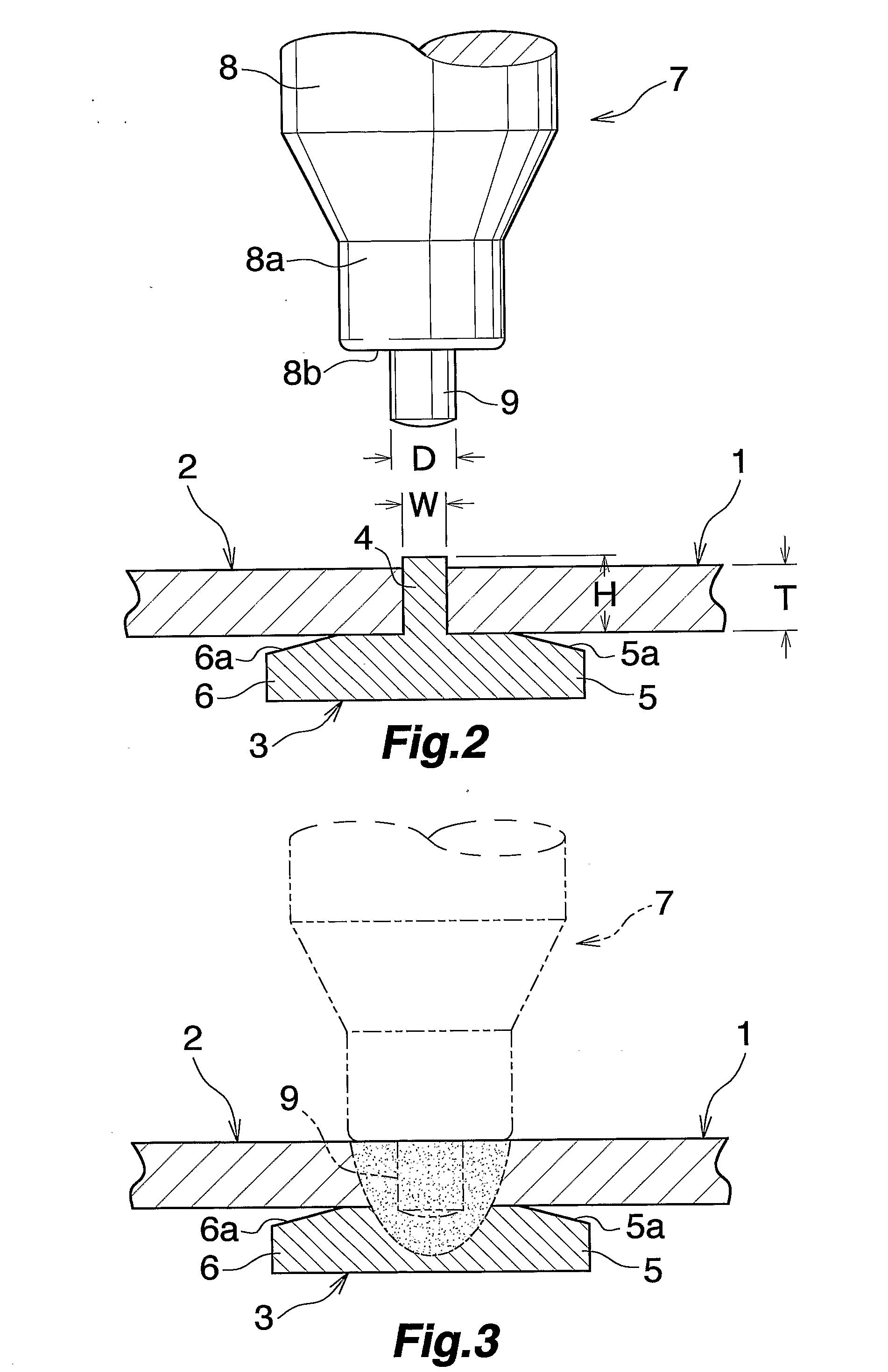Method for Friction-Stir-Welding Hollow Workpieces
a technology of friction-stir welding and workpieces, which is applied in the direction of manufacturing tools, machines/engines, transportation and packaging, etc., can solve the problems of difficulty in disposing the support member at a proper position, risk of occurrence of defect in the joint portion, and reduce the wall thickness of the joint portion, so as to prevent an impairment of the joining strength
- Summary
- Abstract
- Description
- Claims
- Application Information
AI Technical Summary
Benefits of technology
Problems solved by technology
Method used
Image
Examples
embodiment 1
[0036]The present embodiment is shown in FIGS. 1 to 3.
[0037]First, two cylindrical workpieces (1) and (2), each opened at opposite ends, are prepared as members to be joined. Also, an annular (short, cylindrical) support member (3) is prepared. The workpieces (1) and (2) are of the same wall thickness and the same inside diameter; i.e., the inner circumferential length is constant along the overall axial length, so that butt end portions of the workpieces (1) and (2) are of the same wall thickness and the same inner circumferential length. An annular, radially outward projection (4) is integrally formed on the outer circumferential surface of the support member (3) in an intermediate region in the axial direction of the support member (3). Opposite support portions (5) and (6) to be fitted into corresponding open end portions of the workpieces (1) and (2) for supporting the workpieces (1) and (2) from the inside are formed on the support member (3) at the corresponding opposite side...
experiment examples 1 to 7
[0049]Two workpieces (1) and (2) formed of JIS A6061-T6 were prepared. The workpieces (1) and (2) had an outside diameter of 200 mm, an inside diameter of 190 mm, and a wall thickness of 5 mm. Also, the support member (3) formed of JIS A6061-T6 was prepared. The support member (3) was configured as follows: the opposite support portions (5) and (6) excluding the tapered portions (5a) and (6a) has an outside diameter of 190 mm and an inside diameter of 160 mm, and the annular, radially outward projection (4) has an outside diameter of 200 mm and a height H of 5 mm as measured from the outer circumferential surfaces of the support portions (5) and (6). The friction stir welding tool (7) prepared was configured as follows: diameter of shoulder portion (8b) as measured on end face of small-diameter portion (8a) of rotor (8): 15 mm; diameter of probe (9): 5 mm; and length of probe (9): 5 mm.
[0050]With the width of the annular, radially outward projection (4) in the axial direction of the...
embodiment 2
[0058]The present embodiment is shown in FIGS. 5 and 6.
[0059]In the present embodiment, butt end portions of two cylindrical workpieces (20) and (21) to be joined are of the same outer circumferential length, and the outer circumferential surfaces of the butt end portions of the cylindrical workpieces (20) and (21) are positioned at the same cylindrical surface. However, the present embodiment differs from Embodiment 1 in the following: the butt end portions of the workpieces (20) and (21) differ from each other in wall thickness and inner circumferential length; the support member (3) has a first support portion (5) on one side of the annular, radially outward projection (4) so as to support, from the inside, the first workpiece (20) having a thin-walled butt end portion; the support member (3) has a second support portion (6) on the other side of the annular, radially outward projection (4) so as to support, from the inside, the second workpiece (21) having a thick-walled butt end...
PUM
| Property | Measurement | Unit |
|---|---|---|
| Length | aaaaa | aaaaa |
| Thickness | aaaaa | aaaaa |
| Width | aaaaa | aaaaa |
Abstract
Description
Claims
Application Information
 Login to View More
Login to View More - R&D
- Intellectual Property
- Life Sciences
- Materials
- Tech Scout
- Unparalleled Data Quality
- Higher Quality Content
- 60% Fewer Hallucinations
Browse by: Latest US Patents, China's latest patents, Technical Efficacy Thesaurus, Application Domain, Technology Topic, Popular Technical Reports.
© 2025 PatSnap. All rights reserved.Legal|Privacy policy|Modern Slavery Act Transparency Statement|Sitemap|About US| Contact US: help@patsnap.com



